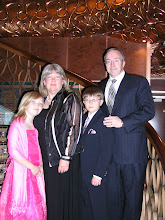Today (January 24, 2009) we traveled through the Panama Canal. It is an amazing engineering structure that was completed in 1914. There is a series of steps to enable ships to get through its 80 km. length that takes you from the Caribbean Sea to the Pacific Ocean.
The Continental Divide is also passed through. This is the highest point where it is determined where waterways will drain or flow to either the Atlantic or Pacific Oceans. For example, in B.C. there is also a point where the Continental Divide is.
Charles I of Spain ordered the first survey of a proposed canal route in 1534 but construction did not occur for about three centuries. It was the French that began construction in 1880. For 20 years they tried dredging out the canal but due to disease (malaria and yellow fever), financial, and engineering problems they had to stop. It is said that 20,000 people died during that construction period. So in 1904, the United States bought the French Canal Company rights and properties for $40 million and they began construction. The canal was completed in 1914 with a total cost of $387 million dollars with a loss of only over 500 lives due to injuries during construction. It is Leonardo da Vinci that is credited to be the mind behind the concept of the lock system.
The Panama Canal is made up of three pairs of locks that raise boats up 26 meters above sea level to the level of Gatun Lake that is situated in the middle of the canal system. It is interesting to note that this lake is a freshwater lake and the dam that was built to form this lake was the largest in the world at that time. As you transit through this lake channel, you then go to another series of three more locks called the Miguel Locks and the Miraflores Locks that lower boats to the sea level of the Pacific Ocean.
Construction is now underway to build an even bigger canal to accommodate larger vessels through the Isthmus of Panama.
I found it interesting that the canal is cut through a very thick jungle. It took us 10 hours to get through the canal and we were moving all of the time. Also, it is amazing how much ships must pay to use the system. Large cruise ships have to pay over $300,000 as a toll to use the canal. Lastly, it is impressive that a ship can save over 7,000 miles or 11,200 km. in distance traveled by using the canal rather than going around South America.
Saturday, January 24, 2009
Subscribe to:
Post Comments (Atom)

Hello World Travellers,
ReplyDeleteIt us Grandpa Ron and Grandma Carolyn,
Carolyn's mother Carole Caine will be following your itinerary and thank-you Adam for your history of the Panama Canal. My son David has been to Panama many times. On one occasion the biological study of the Panamanian Tamarin had to be put on the shelf because of the Noreaga uprising. They returned the next year to continue their work.
We are thrilled for all of you to be having this experience.
We will keep in touch and follow your daily activity.
Much Love and God Bless all of you,
Grandma Carolyn XOXOXOXO
¡Hola, la familia de Boyle!
ReplyDelete(Translation: Hello, Boyle family!)
*Waves* It sounds like you're having fun! I never knew cruise ships had to pay $300,000 just to pass through the canal! Ever notice how the Spanish seem to start these things, but never finish them? My observation ^^
I think I’ve seen pictures of the Panama Canal, and I must say I’m not surprised that it cost so much to build. I guess it’s worth it, though, if you save that much time. And (not meaning to sound insensitive to lives lost), with the cost of only 500 lives. Building something of that grandeur, you’d expect the death toll to be higher, would you not?
Anyways, I hope your trip continues to be as fun as it sounds! I know I’d like to visit there sometime.
~Caelyn
Cool write up on the Panama Canal. I actually learned something. thanks.
ReplyDelete